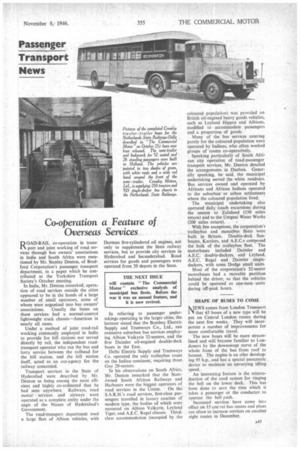Co-operation a Feature of Overseas Services
Page 43

If you've noticed an error in this article please click here to report it so we can fix it.
D OAD-RA1L co-operation in transI% port and joint working of road services through bus owners' associations in India and South Africa were mentioned by Mr. Stanley Denton, of Bradford Corporation's passenger transport department, in a paper which he contributed at the Yorkshire Transport Society's October meeting.
In India, Mr. Denton remarked, operation of road services outside the cities appeared to be in the hands of a large number of small operators, some of whom were organized into bus owners' associations. Usually the buses on these services had a normal-control lightweight truck chassis—American in nearly all cases.
Under a method of joint road-rail working commonly employed in India to provide for hill stations not served directly by rail, the independent roadtransport operator who ran the bus and lorry service between the railhead for the hill station, and the hill station itself, acted as an out-agency for the railway concerned.
Transport services in the State of Hyderabad were described by Mr. Denton as being among the most efficient and highly co-ordinated that he had seen anywhere. Railways, road motor services and airways were operated as a complete entity under the aegis of the Nizam of Hyderabad's Government The road-transport department used a large fleet of Albion vehicles, with Dorman five-cylindered.oil engines, not only to supplement the State railway services, but to provide city services in Hyderabad and Secunderabad. Road services for goods and passengers were operated from 20 depots in the State.
In referring to passenger undertakings operating in the larger cities, the lecturer stated that the Bombay Electric Supply and Tramways Co., Ltd., ran extensive suburban bus services employing Albion Valkyrie 32-seaters, and the first Daimler oil-engined double-deck buses in the East.
Delhi Electric Supply and Tramways Co. operated the only trolleybus route on the Indian continent, requiring three Guy 20-seaters.
In his observations on South Africa, Mr. Denton remarked that the Stateowned South African Railways and Harbours were the biggest operators of
road services in the Union. On the S.A.R.H.'s road services, first-class passengers travelled in luxury coaches of modern type, the bodies of which were mounted on Albion Valkyrie. Leyland Tiger, and A.E.C. Regal chassis. Thirdclass accommodation (occupied by the
coloured population) was provided on British oil-engined heavy goods vehicles, such as Leyland Hippos and Albions, modified to accommodate passengers and a proportion of goods.
Many of the bus services catering purely for the coloured population were operated by Indians, who often worked groups of routes co-operatively.
Speaking particularly of South African city operation of road-passenger transport services, Mr. Denton detailed the arrangements in Durban. Generally speaking, he said, the municipal undertaking served the white residents. Bus services owned and operated by Africans and African Indians operated to the suburban or urban settlements where the coloured population lived.
The municipal undertaking also operated daily coach excursions during the season to Zululand (150 miles return) and to the Umgeni Water Works (200 miles return). • With few exceptions, the corporation's trolleybus and motorbus fleets were built in Britain. Double-deck Sun beams, Karriers, and A.E.C.s composed the bulk of the trolleybus fleet. The motorbuses included Daimler and A.E.C. double-deckers, and Leyland. A.E.C. Regal and Daimler single deckers, with some Dodge small units.
Most of the corporation's 32-seater motorbuses had a movable partition behind the driver, so that the vehicles could be operated as one-manunits during off-peak hours.
SHAPE OF BUSES TO COME MEWS comes from London Transport
14 that 65 buses of a new type will be put on Central London routes during the next few weeks. They will incorporate a number of improvements for more comfortable travel.
The new buses will be more streamlined and will become familiar to Londoners by the downswept curve of the whole front of the bus from roof to bonnet. The engine is an oiler developing 95 h.p., and has a special pneumatic. device to maintain an unvarying idling speed.
An interesting feature is the reintroduction of the cord system for ringing the hell on the• lower deck. This has been done to save the time which it takes a passenger or the conductor to operate the bell push.
Increased services have come into effect on 15 ceirral bus routes and plans arc afoot to increase services on another eight routes in December.




































































